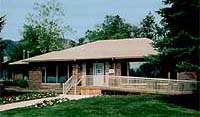 Children’s Justice Center
Children’s Justice Center
I’ve driven by the house at least 100 times, perched as it is at the corner of the turnoff to City Creek Canyon, one of my favorite respites in Salt Lake City. It looks just like many of the houses in the Avenues neighborhood—modest and welcoming. You’d never know it houses a non-profit that communicates with the District Attorney’s office, Salt Lake’s 14 police departments, Child Protective Services, the Guardian Ad Litem’s office, Utah’s Attorney General and Primary Children’s Medical Center every day.
And that’s the point. The building houses the Children’s Justice Center (CJC), the first place a child who’s been a victim of abuse and a concerned adult go to interact with the legal system. After a crime is reported, the house is the first stop in the journey to justice. Rather than going to a police station with its glaring lights, uniforms and intimidating formality, children are welcomed into the house’s cozy living room and invited to play with the multitude of toys that line its walls.
Most of the time, the children become comfortable soon after they arrive. “The children know what to do,” says Program Manager Susanne Mitchell, M.S.W. “They come into the house and start to play in the living room. It’s natural for them to play. It’s often the parents that are the most anxious. We provide support not only for the child; we’re also dealing with the family’s needs at the same time.”
After playtime, children choose which of the playfully decorated interview rooms where they will tell detectives their stories—the soft, yellow butterfly room; the soothing, blue bluebird room; or the blue/green surfer room. Interviews are one-on-one with detectives trained to talk to children in a way that taps into how their unique memories work.
Each interview room has two cameras in full view that record their conversations. “The videos don’t take the place of testimony,” says Susanne. “They are given to police where they are reviewed with prosecutors so that everyone is familiar with the child’s accounting of the story.” Every week representatives of the center, as well as representatives from all the agencies they work with, get together and review active cases to see what everyone has learned. “This helps us determine what else we can do to protect the children,” says Susanne.
The vast majority of clients are victims of sex abuse. Perpetrators are 50/50 family and non-family members, only two percent of which are strangers. All told, children spend about an hour-and-a-half at Children’s Justice Center on their initial visit. But the service doesn’t end there. The center provides information to family members as to where to find services such as family counseling, and they follow up with families to make sure their needs are being met.
It is heartening to learn that from their first stop at CJC to their day in court, children’s special needs—the need for nurturing, non-judgmental communication so that they will feel empowered to tell the truth to a jury when the time comes—are taken seriously. According to Susanne, the District Attorney’s counseling unit takes children to the courtroom where they will testify before their trials and where they tour the room, sit in the judge’s chair and even get to try on the judge’s robe. Susanne says, “This puts them in control of their environment.”
How It All Started
Susanne says the idea for the center came from a juror who sat in a child abuse trial and was horrified by the endless, intense cross-examination of a child who became obviously stressed by the situation. The juror initiated a task force to find out if there was a more supportive and effective way to lead children and their families through the justice system. They recruited Susanne to help them get started. She consulted other programs across the country, and in 1991, CJC opened their doors. Susanne has been with them ever since. Utah has 20 centers scattered around the state, two of which are in Salt Lake City. There are 700 such centers around the U.S.
Susanne’s work rewards her every day. “People come in scared,” she says. “After an hour-and-a-half here, their countenance has changed. It’s really rewarding to see. I get to work with amazing people behind the scenes; our work is all about goodwill for others.”
We at Hugger Mugger Yoga Products are proud to support the Children’s Justice Center. From the beginning of July until the end of September, a percentage of your purchases will be donated to the Children’s Justice Center. Thank YOU for your support of this wonderful organization.
